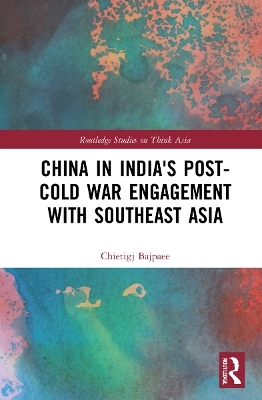
China in India's Post-Cold War Engagement with Southeast Asia
Routledge (Verlag)
978-0-367-46406-6 (ISBN)
This book examines the role of China in driving and sustaining India’s post-Cold War engagement with Southeast Asia. In doing so, it provides a unique insight into the regional dimensions of the Sino-Indian relationship.
India launched its Look East Policy in the early 1990s as part of a concerted effort to revive the importance of Southeast Asia in the country’s foreign policy agenda. This study assesses the role of the China factor – defined here as China’s regional role, which has been interpreted through the prism of the Sino-Indian relationship – in the inception and evolution of the policy. More specifically, it establishes the extent to which China has been raised as a priority in discourses of India’s Look East Policy and how this has varied over time from the origins of the policy through to the most recent phase of the renamed Act East Policy. Addressing the distinction between what policymakers signal in their official statements and their true or underlying motivations, the book alludes to the fact that government officials may not always reflect true intentions in their official statements, and it is often what is not said that may reveal more about their real motivations. This is particularly relevant in the context of the Sino-Indian relationship where diplomatic rhetoric often masks more competitive and confrontational aspects of the bilateral relationship.
An important analysis of the interplay between India’s relations with Southeast Asia and China, this book will be of interest to academics, policymakers and students in the fields of International Relations, Asian Security, Southeast Asian politics, and in particular, Indian foreign policy, the Sino-Indian relationship, and India’s Look East/Act East Policy.
Chietigj Bajpaee is senior research fellow for South Asia in the Asia-Pacific Programme at Chatham House, UK. Previously, he worked with several public policy think-tanks and risk consultancies in the United States, Europe and Asia, including the Center for Strategic and International Studies, the International Institute for Strategic Studies, Control Risks and IHS Markit, and has had visiting fellowships at the Manohar Parrikar Institute for Defence Studies and Analyses and Vivekananda International Foundation. He holds a doctorate from King's College London, UK, and the National University of Singapore.
1. Introduction 2. Deconstructing India’s ‘Look East’ Policy 3. Interplay between agency and structure 4. Launching ‘Look East’ (Until 1996) 5. ‘Look East’ – Phase 1 (Until 2004) 6. ‘Look East’ – Phase 2 (Until 2014) 7. ‘Act East’ – Phase 3 (2014 onwards) 8. Conclusions
| Erscheinungsdatum | 21.02.2022 |
|---|---|
| Reihe/Serie | Routledge Studies on Think Asia |
| Zusatzinfo | 7 Tables, black and white; 7 Halftones, black and white; 7 Illustrations, black and white |
| Verlagsort | London |
| Sprache | englisch |
| Maße | 156 x 234 mm |
| Gewicht | 740 g |
| Themenwelt | Sozialwissenschaften ► Politik / Verwaltung ► Europäische / Internationale Politik |
| ISBN-10 | 0-367-46406-3 / 0367464063 |
| ISBN-13 | 978-0-367-46406-6 / 9780367464066 |
| Zustand | Neuware |
| Haben Sie eine Frage zum Produkt? |
aus dem Bereich


